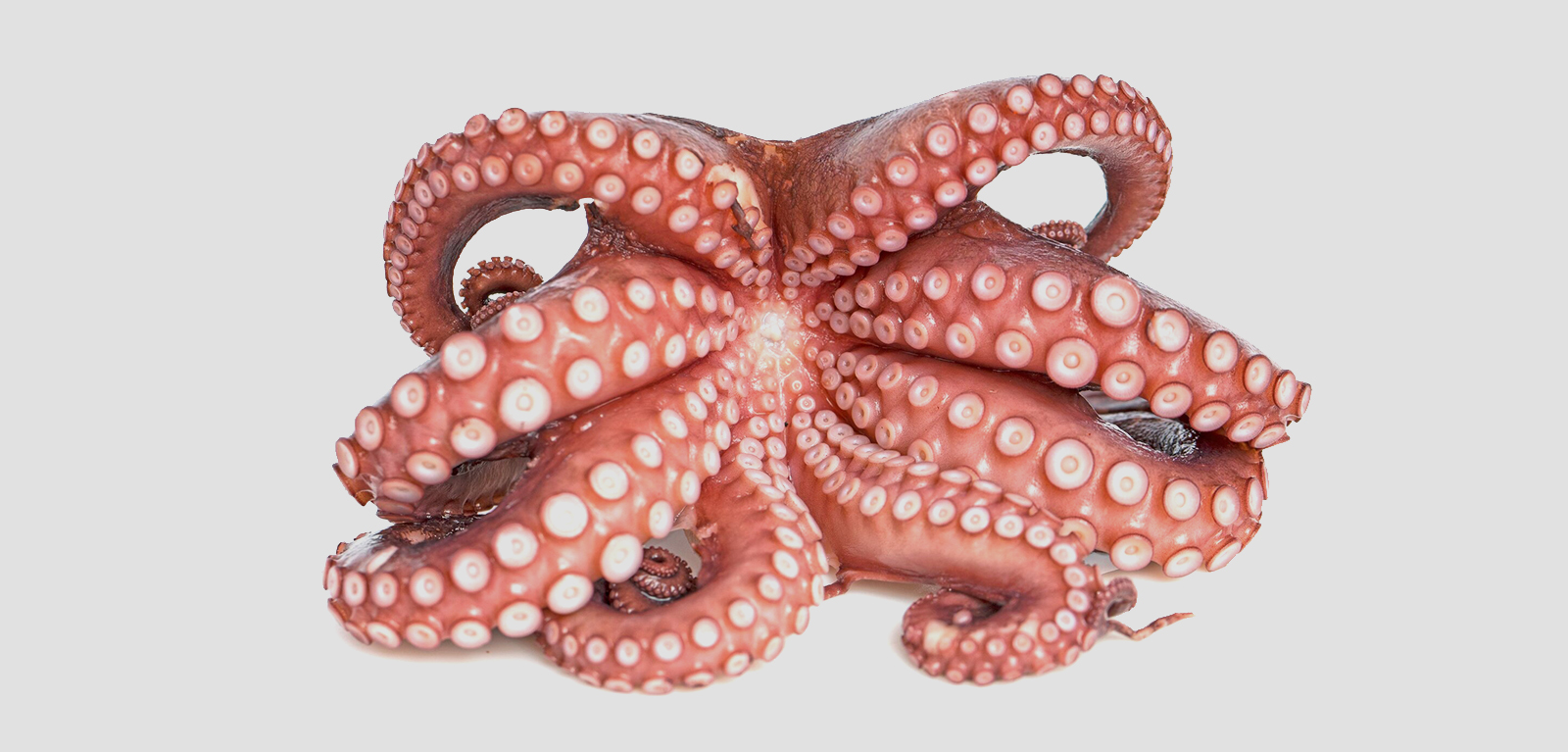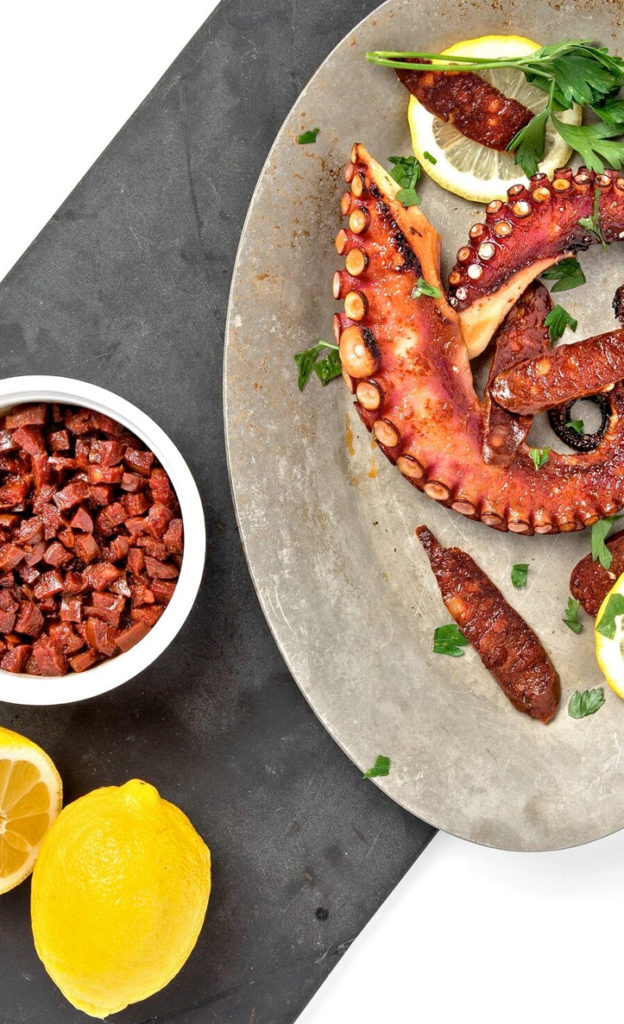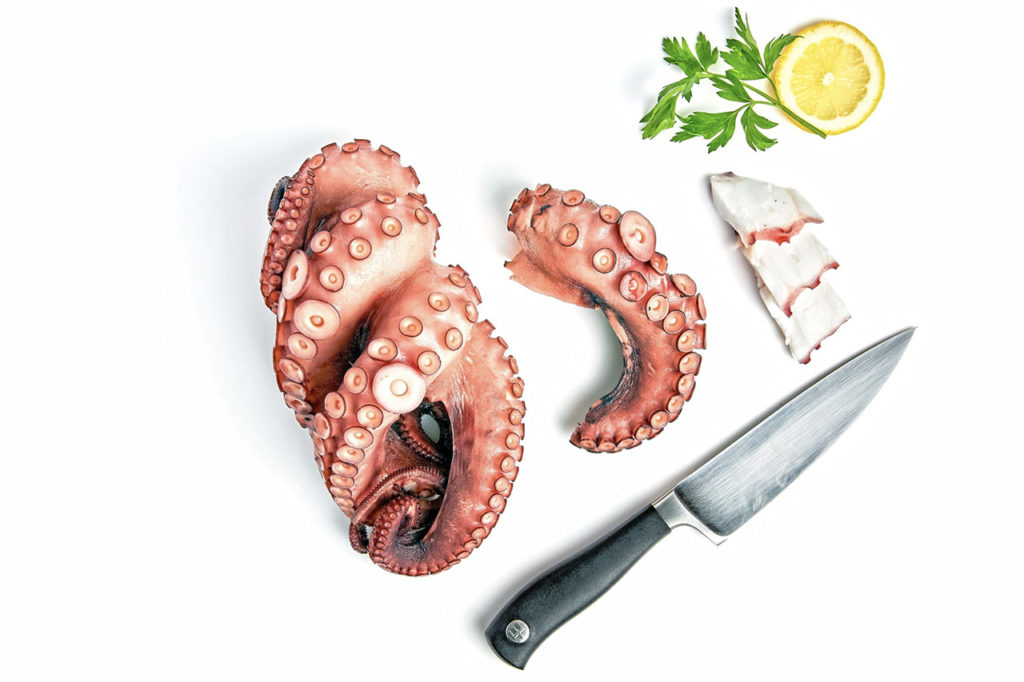GULLO OCTOPUS AND SEPIA
SPANISH OCTOPUS & CUTTLEFISH
Octopus Vulgaris & Sepia
CATCH METHOD:
Nets, Pots, and Traps
OTHER NAMES:
Tako, Pulpo, Mediterranean Octopus, Common Octopus
AVAILABILITY:
Year Round
LOCATION:
Mediterranean Sea, Port of Spain

Tenderization is a method using sea salt, ice water and tumbler. It's an all-natural process where no additives or chemicals are ever used. This process breaks down the muscles of the octopus and gives us what is called "flower octopus".

Spanish
Coast
The coasts of Spain and Portugal are ideal for producing the best Grade A Sushi Quality Octopus
ZEROº
Can be stored at 0º and will last up to two years.

Stephen Fried, Corporate Chef and VP or Business Development is better known as Octoman, and zooms around town on his sea foam green Vespa.

COMMITTED TO QUALITY & SUSTAINABILITY
Gullo’s contracts with 17 individual fishing vessels who fish off the coast of Spain in the Atlantic Ocean & Mediterranean Sea. Their fishermen follow Spain’s strict octopus and cuttlefish fishing limitations in order to ensure the fishing stocks remain healthy and continue to thrive. Once caught these octopus are carefully brought on board and soaked in cold water and sea salt solution to begin the tenderizing process. Once landed they are then taken from the boats and using a specialized tumbler the octopus are carefully tumbled in cold, salty water to naturally and organically help tenderize the meat. This process produces a beautifully tender “flower octopus” with perfectly curled tentacles that are not only visually stunning but also provides higher yields (up to 40% more) compared to traditional non-tenderized cephalopods.
TENDERIZATION MEANS HIGHER YIELD
The team at Gullo Specialty Foods tenderize their octopus using a tumbler, sea salt, and colt water – a natural process with no additives or chemicals. Their process of tenderization provides a significantly higher yield than other products. Gullo Octopus and Sepia yield between 70%-90% depending on size, whereas other producers yield around 50%.
TRACEABLE & SUSTAINABLE
Gullo Octopus and Sepia are caught in zones 34 and 37 off the coast of Spain in the Atlantic Ocean, and in the Mediterranean Sea using Traps and Pots that result in nearly zero by-catch. Once the octopus are caught in netted pots they are carefully raised up from the sea and flash frozen aboard the ship to preserve their freshness.
TENDERIZED SEPIA/CUTTLEFISH
Gullo’s sepia/cuttlefish is the seafood industries most pristine product of its kind. Coming for the waters around Spain, then tumbled and tenderized in sea salt and ice water. Can be eaten raw and tastes like “candy from the sea”. Clean and mild taste. Very tender. Can eat raw. Can be grilled, or cooled ala plancha, sautéed, and fried.
SQUID
Gullo offers 2 types of squid. Our premiere line is from Port Judith Rhode Island, home of some of the best tasting squid in the world. This squid has been naturally tenderized and is perfect for grilling. Tubes and Tentacles available. Pack size is (fill in here)
Our other squid is also domestic and is from the Ilex special. Its best fr frying and comes in tunes and tentacles.
CULINARY
Cooking with Gullo Octopus and Sepia

Our cooked octopus legs/tentacles are our no. 1 selling product. 100% yield, wild-caught, sushi-grade, tenderized with sea salt & ice water then tumbled.
Charred Octopus
(Cooked, Serves 6)
Heat 4 Tbsp. oil in a large pot over medium-high heat. Cook onion, carrot, and celery, stirring often, until softened, 8–10 minutes. Add coriander seeds and paprika and cook, stirring, until fragrant, 2 minutes. Add wine, vinegar, and 6 cups water; season with salt and pepper and bring to a boil.
Add octopus to liquid, reduce heat, and partially cover pot. Simmer gently, turning octopus occasionally, until flesh is tender enough to cut with a spoon, 60–75 minutes. Transfer octopus to a platter with a slotted spoon; let cool. Rub off skin with paper towels. Separate tentacles and cut into equal lengths.
Heat a large skillet, preferably cast iron, over medium-high heat. Toss octopus with 1 Tbsp. oil and season with salt and pepper. Cook, turning occasionally, until charred, 8–10 minutes. Brush with chili sauce (you may not use all of it) and cook, turning occasionally, until sauce is deeply caramelized, about 5 minutes. Remove from heat and toss with butter to coat.
Toss herbs, lime juice, and 1 Tbsp. oil in a small bowl; season with salt and pepper. Swipe yogurt across plates and top with octopus, then herb salad; drizzle with more oil.
Ingredients
2 garlic cloves
1 1” piece ginger, peeled
1 red Thai chile
½ cup hot chili paste
2 tablespoons fish sauce
1 tablespoon fresh lime juice
1 tablespoon gochugaru (Korean red pepper powder)
1 tablespoon unseasoned rice vinegar
Purée garlic, ginger, chile, chili paste, fish sauce, lime juice, gochugaru, and vinegar in a blender until smooth.
GRILLed Octopus
(Cooked, Serves 6)
- Fill a large pot 1/2 full with water. Add 2 tablespoons kosher salt, peppercorns, and the wine cork; bring to a boil over high heat.
- Meanwhile, place octopus on a cutting board. Using a wooden spoon or meat mallet, pound the octopus multiple times, starting in the middle and moving down each tentacle to tenderize the meat.
- Dip tentacles into the boiling water 3 times, holding them in the boiling water 2 to 3 seconds each time, until the tentacles curl up. Submerge entire octopus in the boiling water. Bring water back to a boil, reduce heat to low, cover, and simmer until octopus is fork-tender, 45 to 60 minutes. Remove from heat and cool for 30 minutes.
- Preheat an outdoor grill for medium-high heat and lightly oil the grate.
- Grill octopus until charred on all sides, 3 to 4 minutes per side.
- Remove from heat, slice into pieces, and place on a serving platter. Drizzle with extra virgin olive oil, squeeze lemon over top, sprinkle with parsley, and season with salt and pepper to taste. Serve immediately.
Preparing octopus sushI
(Cooked, Serves 6)
4-5 pounds frozen octopus
Kombu (Japanese kelp)
2 oz sea salt
Daikon (Japanese radish)
Water
- Put on a pot of water, about a gallon, and add a good sized piece of kombu and about 2 oz of sea salt. Bring to a boil.
- Thaw octopus in cold water, then drain well.
- Knead the octopus with a large amount of fresh grated/chopped daikon radish and sea salt. What this does is to clean off any slime, and it also tightens the skin up just a bit. While doing that, turn the head inside out and check for any leftover viscera. Remove any that’s found, then return the head sac to it’s correct shape.
- Using a fork, dunk the octopus into the boiling water a few times until the tentacles curl up. Lower the heat a bit, and then simmer the octopus for about 5-10 minutes. After that turn the heat off and cover the pot.
- Let the octopus cool in the liquid for at least an hour, then into the fridge the whole thing goes. Overnight is great if you can manage it, it’s the slow cooling that tenderizes it. Remove the octopus from the water and let it dry a bit. Slice on an angle, then serve as you like.
You’ll probably find the skin around the head to be very tough. This skin is better off discarded. The very top of the tentacles where they conjoin into the head will probably also have a gelatinous layer right under the skin that’s not too edible either so should be removed as well.
